Project management lies at the core of the success of your marketing campaigns, but it is often overlooked.
Choose the wrong tool, and you're setting yourself up for failure before you even begin:
The project's resources are misaligned, communication is not transparent, and project goals are not met.
Thus, having good project management software is paramount. It helps you build a command centre for all your projects and resources while keeping stakeholders in the loop.
We’ve tried and tested each tool to share their use cases, top features, strengths and drawbacks to help you make an informed decision.
Factors to Consider When Evaluating Marketing Project Management Software
Look for the following features to find the best project management tool to plan and manage your marketing tasks and projects.
Customizable workflows
To manage your projects from planning to execution, you need a customizable tool to adapt to changing requirements during the project’s life cycle.
Ensure that the tool helps you:
- Develop project-specific dashboards.
- Create templates to share internally and reduce work overload.
- Build automated workflows to eliminate routine tasks like approvals, status updates, etc.
Flexible project views
Look for a project management tool that caters to everyone's preferences through multiple views.
- Gantt charts for visualizing task dependencies and project timelines.
- Kanban boards for campaign management and task prioritization.
- Calendar view for tracking publishing and execution schedules.
- Timeline view to track project duration and deadlines.
- List views for a quick overview of the task list.
Reporting and analytics
Sharing project-end reports or per-campaign reports is vital to measure the success of your campaigns. To do this, ensure that the tool.
- Integrates with existing analytics tools such as Tableau, GA, and PowerBI.
- Helps you build custom reports by pulling data from your project dashboards.
- Offers easy sharing and exporting options for visibility across the project team.
Collaboration and communication tools
Real-time, consistent communication is key to managing marketing projects. You should look for:
- Task and project-level comments and @mentions.
- In-app messaging for 1:1 or group chats with stakeholders and teammates.
- Option to build project-specific chat channels to keep conversations organized.
Integrations with marketing software
To expand the collaboration beyond your workspace, ensure the tool integrates with your existing stack. Look for these integrations:
- Social media management platforms: Hootsuite, Buffer, Sprout Social.
- Design and creative tools: Figma, Adobe Creative Cloud, Canva.
- Content management systems: WordPress, Ghost, Webflow.
- CRM tools: Salesforce, HubSpot CRM, Pipedrive.
- Automation tools: Marketo, Zapier, Make.
Resource management
The project management tool should help plan project resources, balance resource allocation, and assess the team’s capacity.
Features like time tracking, dashboards, and budget planning are some key ones you should monitor.
We analyzed 30+ project management software based on several factors and shortlisted our top picks.
Let’s dive in!
10 Top Marketing Project Management Software
Here are our top marketing project management software picks for 2024 based on our research and after looking at 100+ user reviews:
- SmartSuite: Marketing project management platform that combines automation with a personalized workspace to help you plan, manage, and track projects of all sizes.
- ClickUp: Managing large-scale marketing projects with a DIY approach.
- Hive: Multipurpose collaboration to manage projects and communicate effectively.
- Trello: Manage and track marketing campaigns using Kanban boards.
- Teamwork: Client project management across various clients and collaboration.
- Monday.com: Managing complex projects with flexible dashboards.
- Asana: Building flexible workflows through dependencies and automation.
- Wrike: Managing marketing campaigns across multiple teams.
- Workzone: Multiple marketing campaign management with built-in time tracking/.
- Basecamp: Centralized campaign management–from ideation to execution.
#1: SmartSuite
SmartSuite is a versatile marketing project management software that combines automation with a tailored workspace to help you plan, manage, and track projects of all sizes.
Our tool unites all teams, ensuring streamlined information exchange to get work done quickly.
Its intuitive dashboards, powerful automation builder, and native collaboration make it a preferred choice for marketing teams and managers.

Centralize request forms and approvals
Instead of gathering customer feedback or stakeholder changes across various channels and compiling them in your task management tool, SmartSuite eliminates the manual work through request forms.
These forms help you collect all the information at the start of the project, reducing delays once you initiate it.

Drag-and-drop form builder
You can build custom forms using SmartSuite’s drag-and-drop builder:
- Add or remove fields, change field type, or add custom fields like dropdown menus.
- Add multimedia items, such as images, videos, or GIFs, to provide more context to clients.
If you're collecting feedback on your website layout, you can add a snapshot of the layout, a rating menu, and a description field for clear and detailed feedback.

Dynamic forms
Dynamic forms in SmartSuite use conditional logic to show or hide fields based on previous responses. This lets you:
- Create branching logic in your forms.
- Display only relevant questions to each respondent.
- Customize the form experience based on user input.
You can design a form for website homepage redesign with conditional logic to display specific questions based on previous responses.
For instance, if a respondent selects "copy changes," subsequent questions focus on website copy.
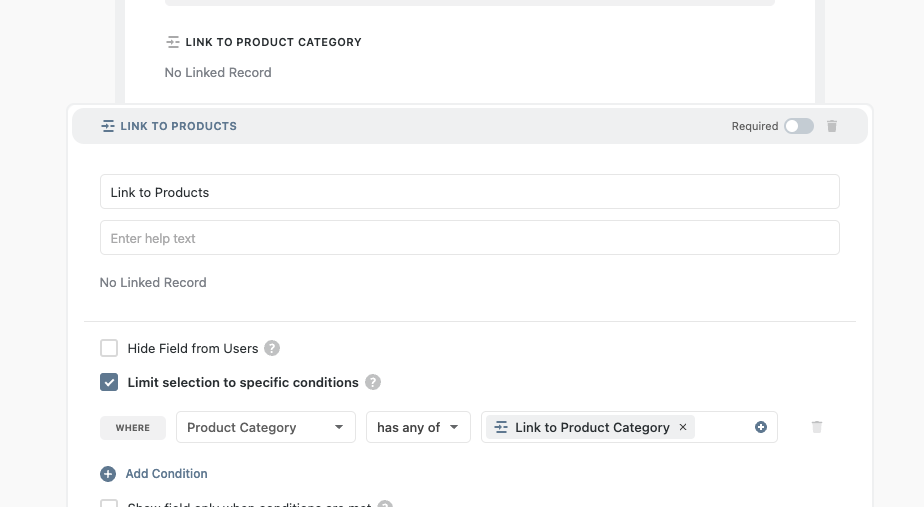
Plan and manage creative marketing campaigns
SmartSuite’s project management dashboard offers a 360-degree view into your project’s life cycle—prototyping, review, and refinement.
You can brainstorm design improvement ideas, assign responsibilities, and build reports in one tool.
- Vote and rating field: Collect feedback on the prototype and final design with the vote and rating field. View and present these ratings as charts in the reporting dashboard.
- Automate recurring tasks: Build linear to multi-sequence workflows to update status, track progress, and assign tasks without manual effort. Set up automation once and use it forever.
- Task management: Convert any record type into tasks and add different fields–subtasks, checklists, and sub-items. Enhance each task with notes and comments for the assigned person.
- Milestone tracking: Break down project goals into task-based milestones to monitor progress. Configure tracking by workstream, team, and owner, flag roadblocks, and create resolution plans.
- 200+ creative project management templates: Access pre-built templates for use cases like product catalogs, video production, press tracking, and user research. Each template has multiple workviews, letting you set up tasks easily.

Keep everyone updated with native team collaboration
If your team isn’t using dedicated project management, crucial feedback is likely getting lost in long email threads or Slack messages.
SmartSuite’s built-in communication and collaboration features help centralize communication.
The conversation happens where the work is, in your project management tool.

Here are the key features that make collaboration easy in SmartSuite.
- Built-in communication center for connecting with peers in group chats or 1:1 conversations for quick feedback and keeping stakeholders updated throughout the project.
- The member’s directory lets you see all the details about your co-workers, including their availability status and job profile, making it efficient to contact the right people.
- SmartSuite docs help you brainstorm with your teams, map out the campaign’s resources, or do a SWOT analysis. All this happens in your work management platform ensuring smooth collaboration and task assignments.

- SmartSuite integrates with Gmail and Outlook, allowing you to send and receive email within your workspace.
- Share updates, nudge teammates, or add new people to the conversation through task and project comments and @mentions.

SmartSuite Pricing
SmartSuite offers a forever-free plan with access to 250+ automation actions, team collaboration, multi-dashboard views, and more.
There are four paid plans with a 14-day free trial:
- Team: Starts at $12/user/month, including SmartSuite AI, Gantt charts, timeline views, 5000 automation runs, and time tracking.
- Professional: Starts at $28/user/per month, including, two-factor authentication, Gmail & Outlook integrations, resource management, and advanced permission control.
- Enterprise: Starts at $41/user/month, including 500,000 automation actions, audit logs, data loss prevention, and 50,000 monthly API calls.
- Signature: Customized plan tailored to your organization’s needs and team size.

SmartSuite Pros and Cons
✅ Generous free plan with access to advanced features.
✅ 200+ project templates for various use cases.
✅ Integrated document and file management.
✅ Comprehensive workflow automation.
✅ Dynamic dashboards and reporting.
❌ Less native integrations when compared to alternatives.
#2: ClickUp
Best for: Managing large-scale marketing projects with a DIY approach.
ClickUp is an all-rounder cloud-based project management software.
The software offers a power base for marketing teams to manage campaigns, brainstorm ideas, develop strategy documentation, collaborate with stakeholders, and track project goals.
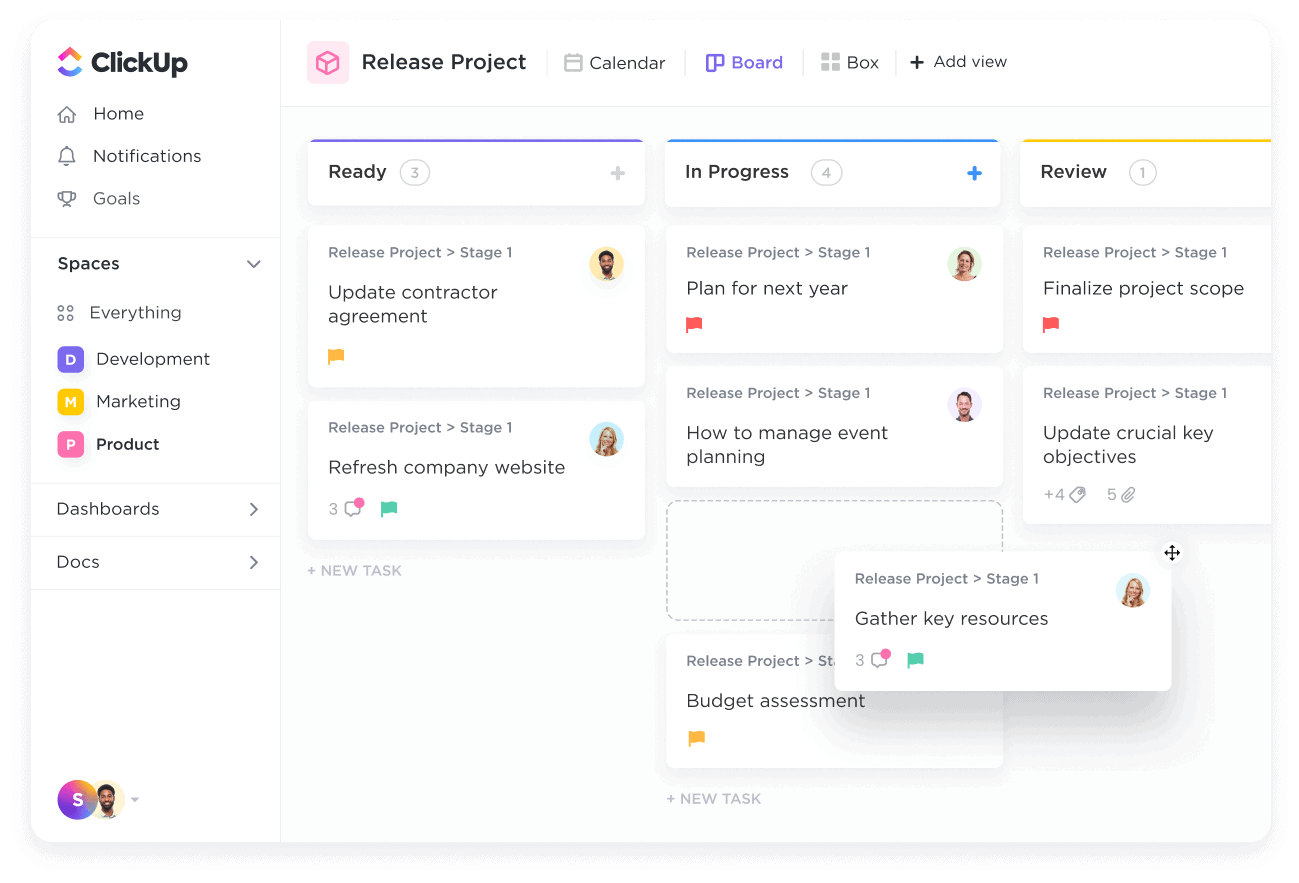
Who Is It For?
Marketing consultants, marketing agencies, and small-to-large businesses.
ClickUp’s Top Features
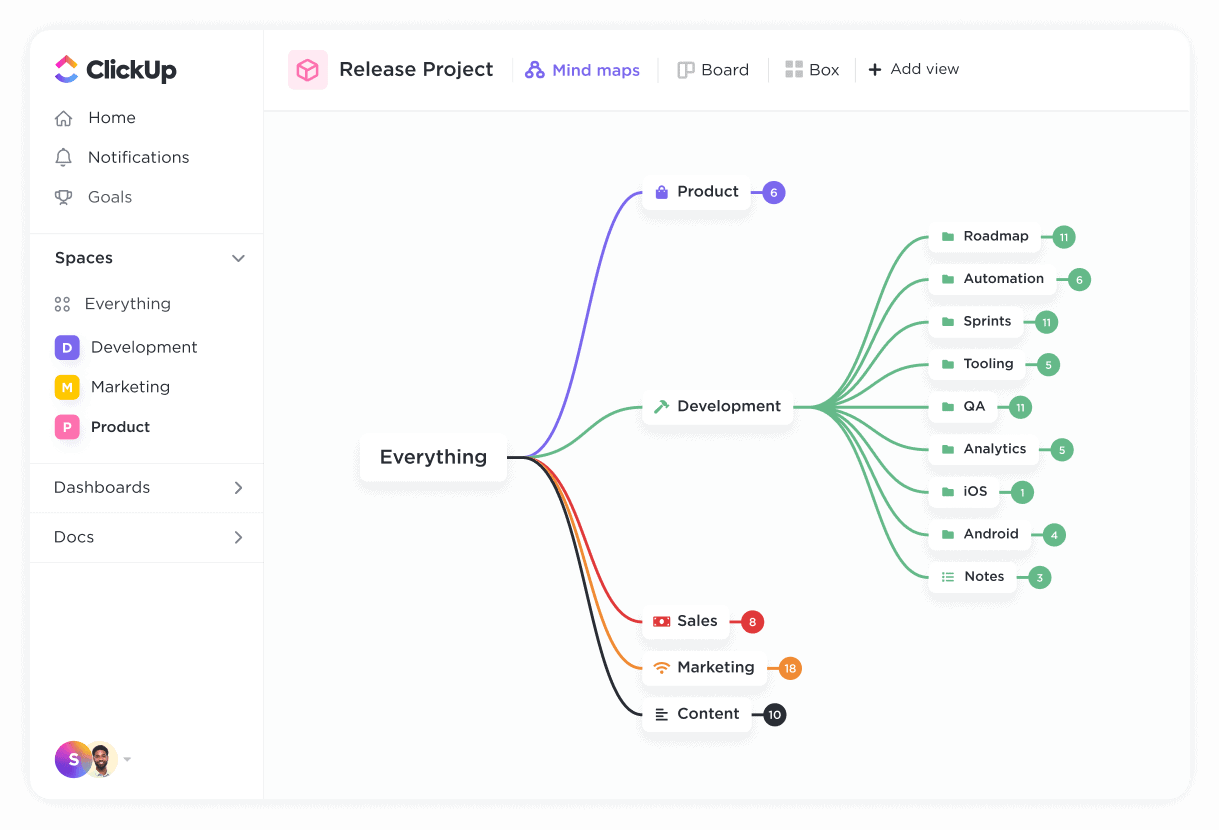
- Goals tracking: Map out your project's goals, boil them down into milestones, and assign metrics to track progress.
- Whiteboards: Collaborative workspace for brainstorming sessions. Using whiteboards you can generate campaign ideas, map out user’s journeys, and structure your team’s responsibility without external tools.
- Folders and tasks: Use folders as the main projects and add tasks to move the needle toward your goals. Folders and tasks keep your campaigns organized and easy to navigate.
ClickUp Pricing
ClickUp’s free plan includes unlimited task creation, 100 MB storage, and collaborative docs.
It offers three paid plans with a 14-day free trial:
- Unlimited: Starts at $10/user/month, offers unlimited custom views, timesheets, guest access, and 100 mind map creations.
- Business: Starts at $19/user/month, offers private docs, sprint reporting, and all dashboard views.
- Enterprise: White labelling, top-notch security, and enterprise AI. Contact sales for a quote.

ClickUp Pros and Cons
✅ Low entry-level pricing.
✅ Highly customizable with many built-in tools.
✅ Native team management and collaboration tools.
❌ Can overwhelm new users due to the complex interface.
❌ Usually takes longer to set up a fitting dashboard.
#3. Hive
Best for: Multipurpose collaboration to manage projects and communicate effectively.
Hive is a cloud-based project management software that helps marketing teams organize campaigns and boost productivity.
You can track multiple projects, build custom workflows, set up request forms, and chat with your co-workers in real-time.

Who Is It For?
Suitable for teams of all sizes–from start-ups to large enterprises.
Hive’s Top Features
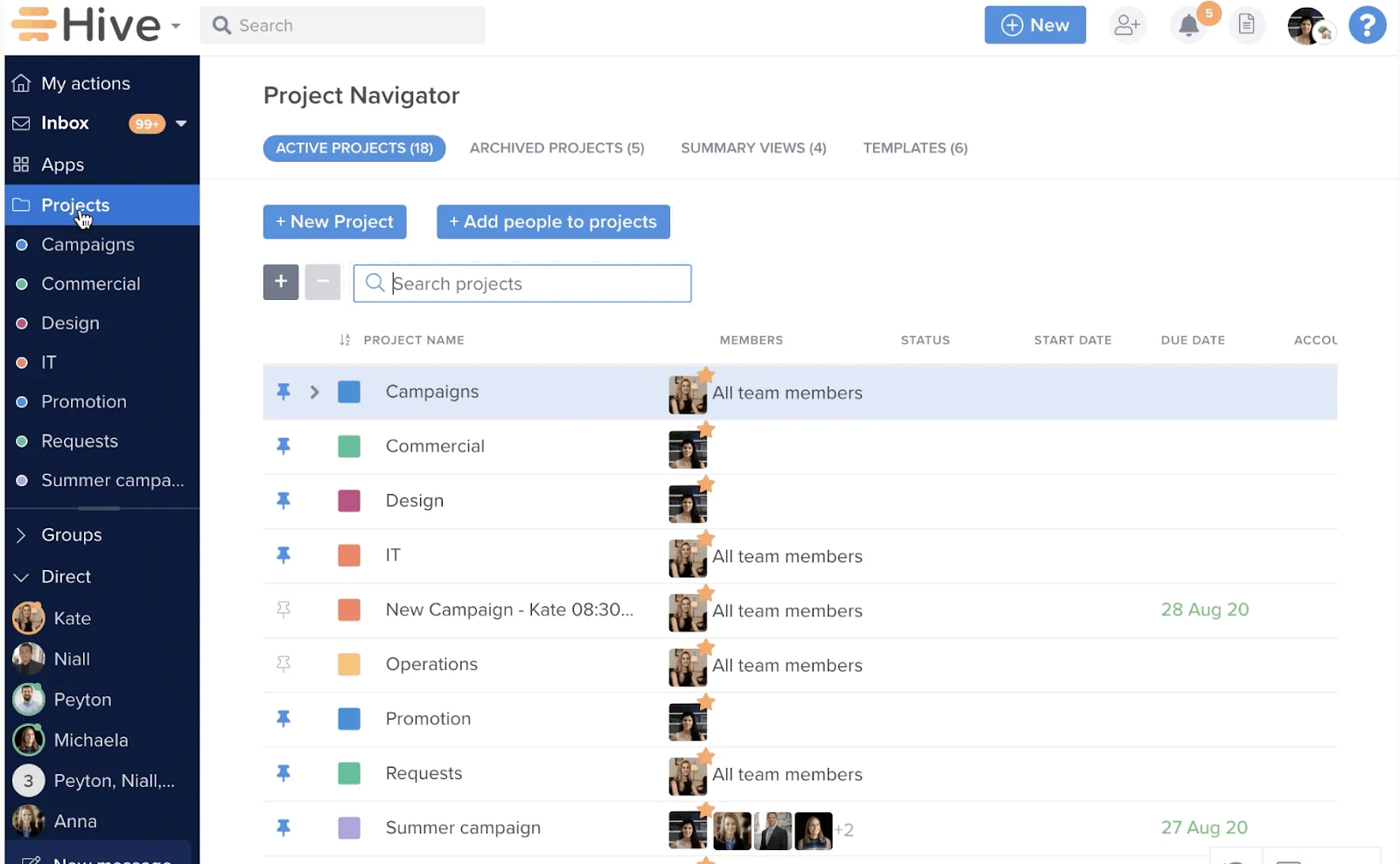
- Built-in communication tools: Text messaging and video calling options for private and group chats.
- Automation: Build triggers to automate repetitive tasks, such as status updates, task assignments, or email updates.
- Form builder: Set up custom forms to collect feedback, requests, or orders. Automatically convert form responses into action cards.
Hive Pricing
Hive offers a forever free plan with up to 10 workspace members and a 14-day free trial. Using per-user pricing, Hive offers three paid plans:
- Starter: Starts at $7/user/month with unlimited storage, up to 10 workspace members, and 10 projects.
- Teams: Starts at $18/user/month with unlimited workspace members.
- Enterprise: Custom pricing (Custom analytics & reporting dashboard, enterprise API, and dedicated CSM).
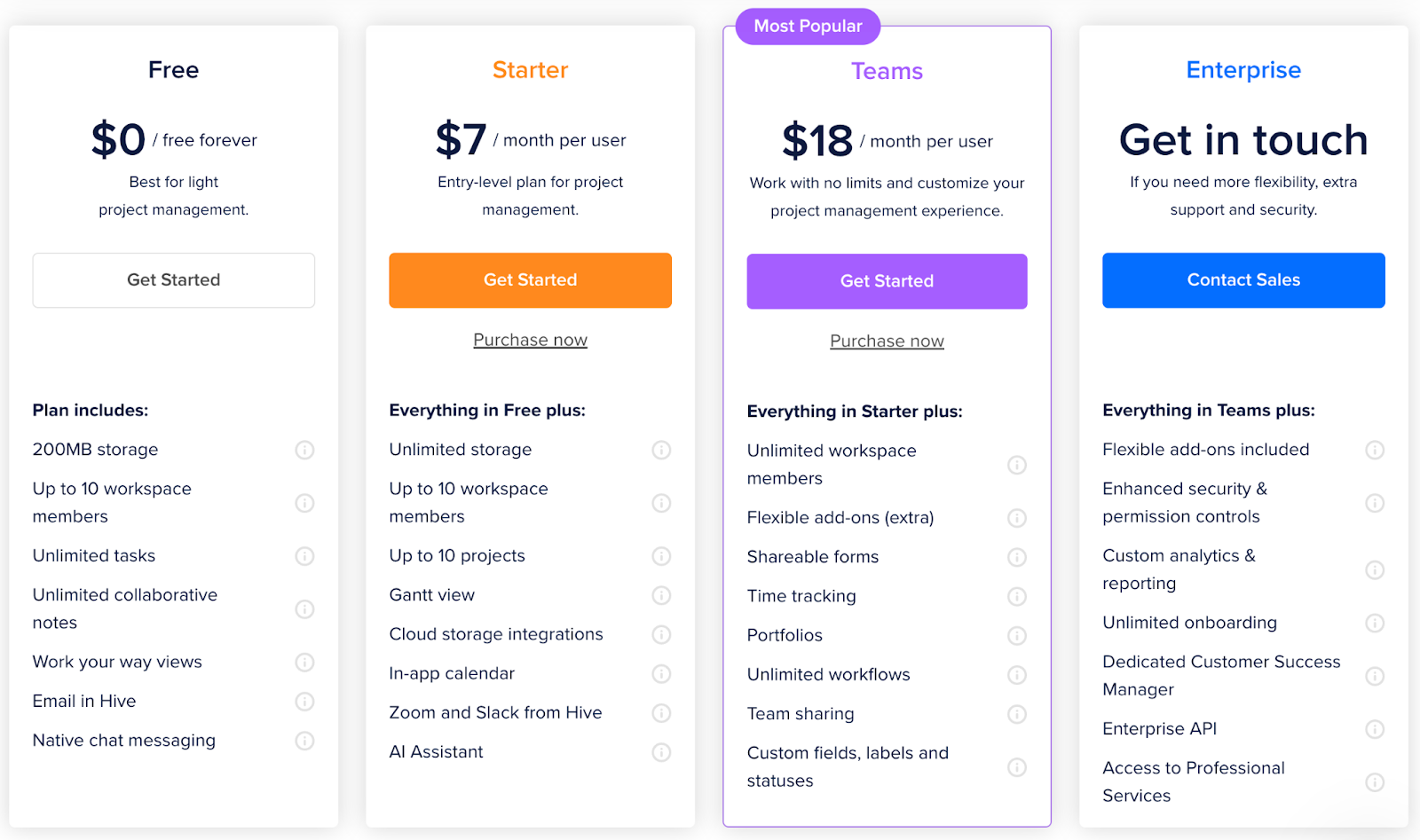
Hive Pros and Cons
✅ Built-in AI-powered tools.
✅ 100+ templates for different use cases.
✅ Multiple dashboard views.
❌ Custom analytics and reporting are only available on the enterprise plan.
❌ Limited native integration with heavy reliance on Zapier.
#4: Trello
Best for: Manage and track marketing campaigns using Kanban boards.
Trello is a low-cost project management software for creatives managing client work and side projects. It helps plan, track, and manage projects using a Kanban board and list view.
Its ease of use, wide range of templates, and drag-and-drop functionality make it a handy tool for managing marketing campaigns, tracking projects, and reporting.

Who Is It For?
Freelancers, solopreneurs, marketing agencies, and small businesses.
Trello’s Top Features

- Automation: Automate routine tasks to free up time for strategic thinking and campaign reporting. Trello’s automation builder, the Butler, also recommends automation based on your activity and trigger history.
- Power-ups: 150+ apps and integration to expand Trello’s workspace capability—automation, time tracking, communication, and analytics.
- Task management: The timeline, list, dashboards, Kanban, and calendar view provide a detailed view of your tasks' progression. With drag-and-drop capability, you can easily move tasks from one card to another.
Trello Pricing
Trello offers a free plan with built-in automation and 10 workspace collaborators. You get a 14-day free trial for its three paid plans:
- Standard: $6/user/month with unlimited activity log, advanced checklists, and 250 automation runs/month.
- Premium: $12.50/user/month with unlimited workspace collaborators, all work views, and built-in automation.
- Enterprise: $17.50/user/month with 24/7 enterprise admin support and SAML SSO via Atlassian Access. Per head cost decreases with team size.

Trello Pros and Cons
✅ User-friendly and intuitive dashboard.
✅ Ease of use across devices.
✅ Built-in advanced automation.
❌ No built-in team communication.
❌ Table, Calendar, Timeline, Map, and Workspace view start only on the premium plan.
❌ No task assignment features for members.
#5: Teamwork
Best for: Client project management across various clients and collaboration.
Teamwork’s client-facing tools are ideal for creative and marketing teams across industries.
Features like client onboarding, budget planning, invoicing, and time tracking make it an all-around project management software.
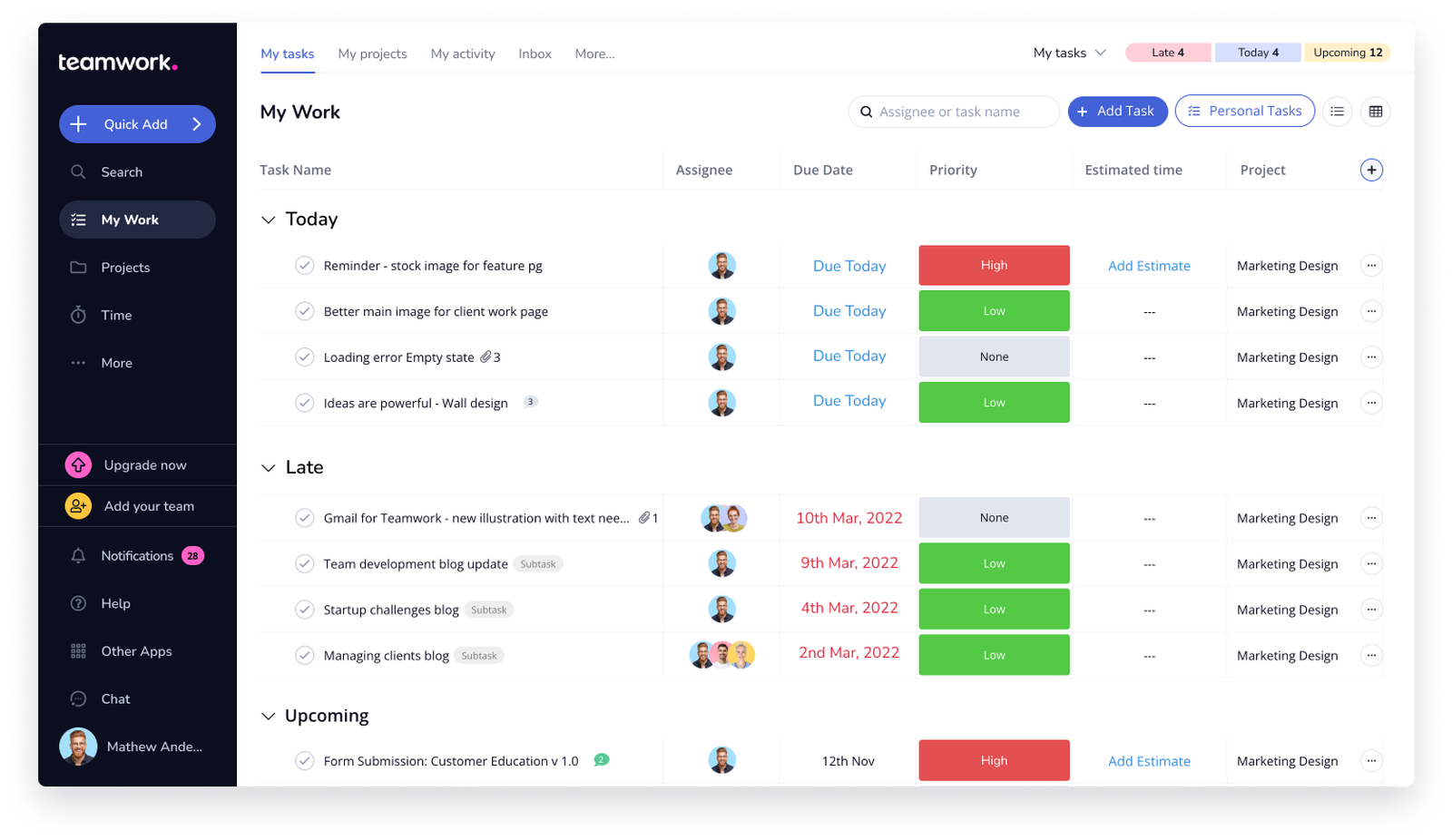
Who Is It For?
Client-service businesses–marketing agencies, consulting firms, and creative agencies.
Teamwork’s Top Features

- Team communication and collaboration: Share updates with clients, get approvals, and communicate internally with a built-in messaging app, comments, and @mentions.
- Resource planning: Assess your project’s health, understand the team's workload, and re-allocate resources to maintain peak efficiency.
- Time and invoice tracking: Use the time tracking field to estimate billable hours and manage invoices within your workspace.
Teamwork Pricing
Teamwork.com offers a forever free plan for up to 5 users and four paid plans with a 30-day free trial.
- Deliver: $13.99/user/month for a minimum of 3 users, billable time tracking, client company management, and Gantt charts.
- Grow: $25.99/user/month for a minimum of 5 users, resource scheduling, utilization report, and a custom domain with SSL.
- Scale: $69.99/user/month for a minimum of 5 users, unlimited retainer management, projects, and advanced automation with conditional logic.
- Enterprise: Dedicated Customer Success Manager, premium support, and advanced security. Contact sales for a quote.

Teamwork Pros and Cons
✅ Customizable workflows and templates.
✅ Built-in resource management tools—time tracking, invoicing, and budgeting features.
✅ Ease of collaboration with external users like vendors or contractors.
❌ Group pricing leads to expensive plans for solo teams.
❌ Limited native integration, relying on Zapier.
#6. Monday.com
Best for: Managing complex projects with flexible dashboards.
Monday.com is a robust project management tool to help marketing teams streamline various campaigns and creative work.
You can build monthly content calendars, plan and launch holiday promotional campaigns, and map out quarterly marketing strategies.
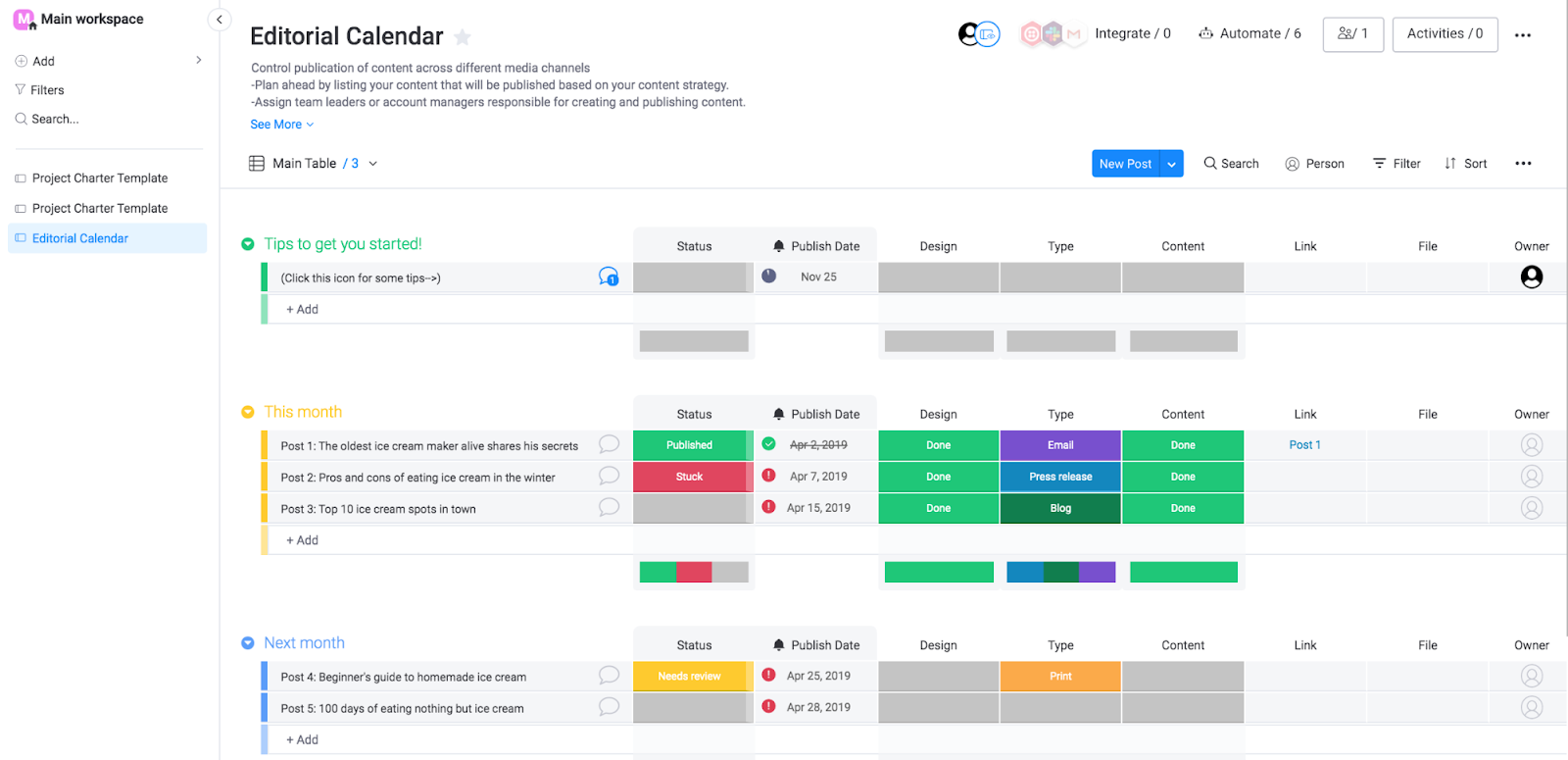
Who Is It For?
Medium and large-scale businesses who want an adaptable project management tool.
Monday.com’s Top Features

- Gantt charts: Visualize task dependencies, see the project’s timelines at a glance, and identify any blockers across the projects.
- Asset management: Store, view, and manage your project-related assets—social media assets, strategy documents, and website graphics—in one place.
- Automation: Workflow automation to create project boards, set approvals and reminders, and standardize processes across organizations.
Monday.com's Pricing
Monday.com offers a 14-day free trial and a free plan for up to 2 users.
Their paid plans are based on a minimum team size of 3 and come in four categories:
- Basic: Starts at $17/user/month with only Kanban boards view.
- Standard: Starts at $20/user/month with 250 automated actions/month and 3+ dashboard views.
- Pro: Starts at $32/user/month with all five dashboard views and 2-factor authentication.
- Enterprise: For enterprise-level reporting and administration control. Contact sales for a quote.
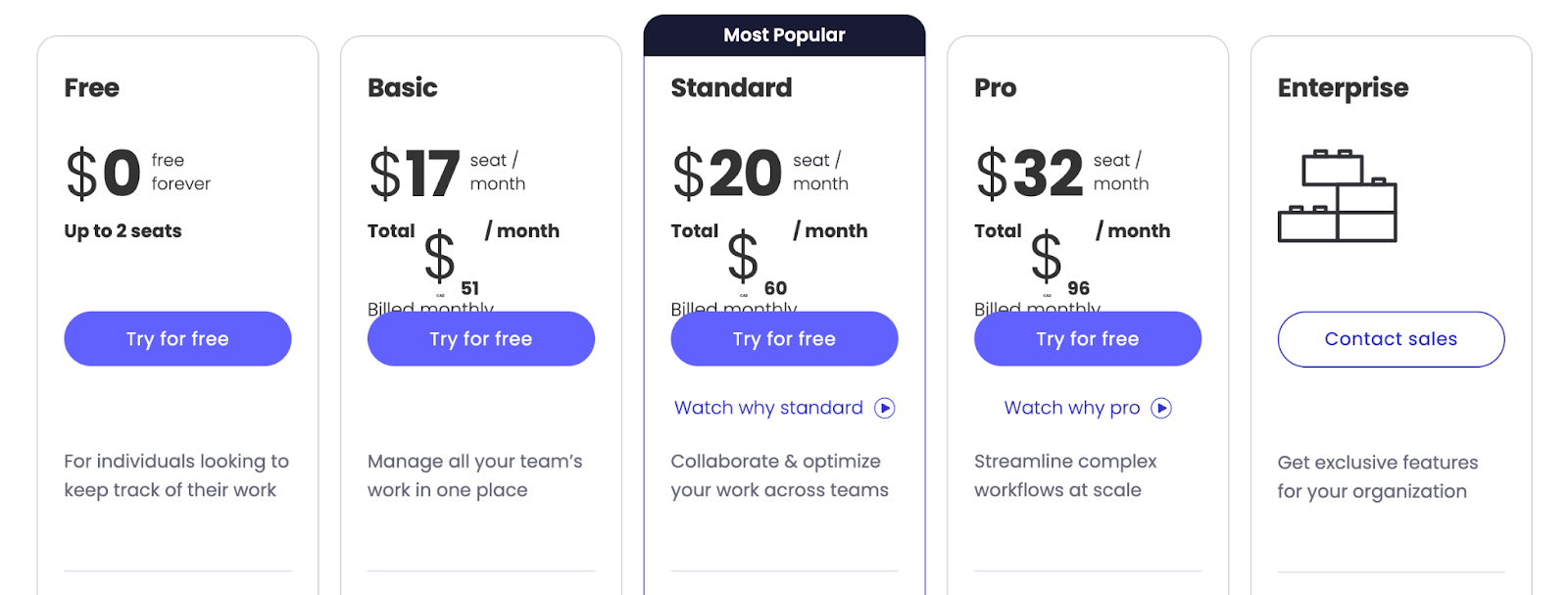
Monday.com Pros and Cons
✅ Multiple customization options.
✅ No-code automation builder.
❌ Steep learning curve.
❌ Expensive and confusing plans.
❌ Slow loading time and constant screen lag.
#7: Asana
Best for: Building flexible workflows through dependencies and automation.
Asana is a project management platform that helps marketing teams streamline campaign planning, tracking, and execution through automated workflows, dependencies, and portfolios.
The built-in portfolio helps you organize multiple projects, giving you access to all documents, tasks, and due dates in one place.
Dependencies let you build a hierarchical work structure while automation handles recurring tasks.
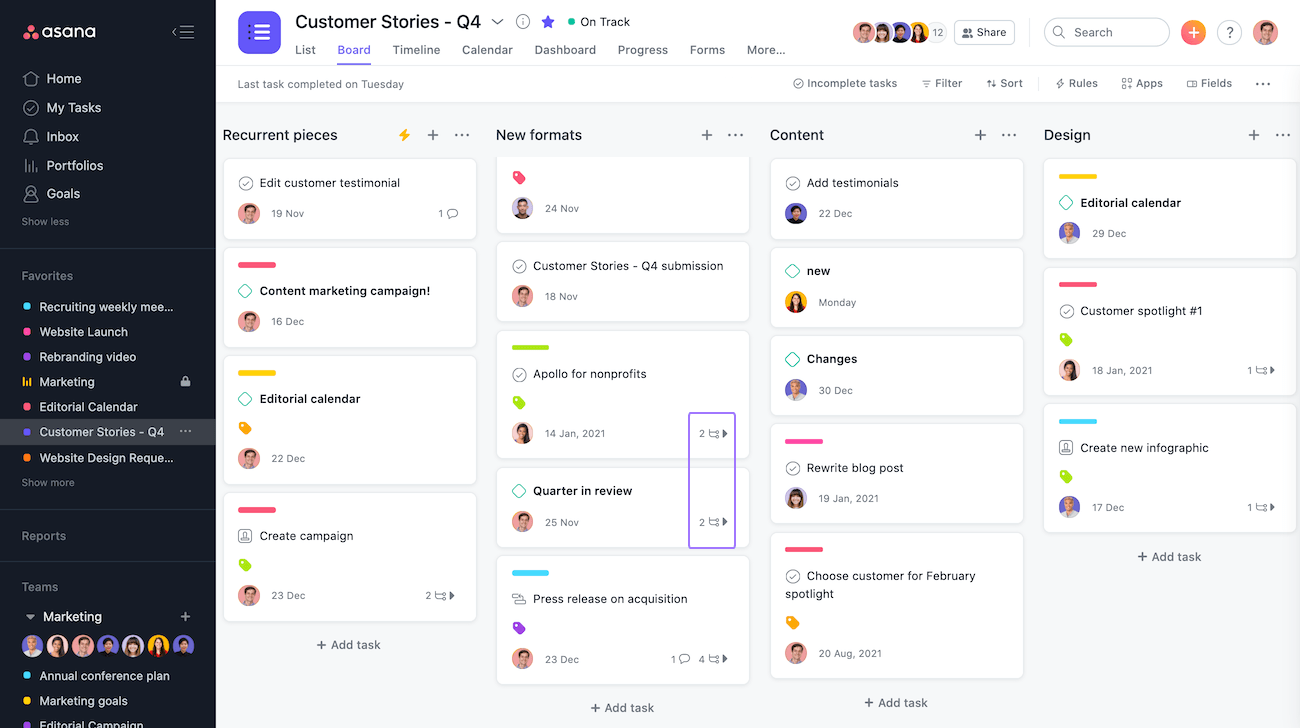
Who Is It For?
Creative and marketing agencies, small and medium-sized businesses.
Asana’s Top Features

- Request forms: Create standardized templates and send them to prospective clients to immediately collect all details. This helps you gather the information needed to start any project.
- Capacity planning: Optimize resources (time, people, and cost) by understanding your team’s workload, task prioritization, and project goals.
- Portfolios: Organize multiple marketing projects in dedicated portfolios. Each campaign can be a portfolio, giving an overview of the task lists, the team involved, and overall progress.
Asana Pricing
Asana offers a free plan for up to 10 users, unlimited file storage (100MB per file), and three task views—board, list, and calendar.
There are four paid plans with a 30-day free trial.
- Starters: Starts at $13.49/user/month, with up to 500 teammates collaboration, Asana AI, private projects, and teams.
- Advanced: Starts at $30.49/user/month, with 25,000 automation/month, 100 portfolios, universal reporting, and goal tracking.
- Enterprise: Advanced integrations, unlimited seats, portfolio, and automation bundles. Contact sales for a quote.
- Enterprise+: Audit log API, HIPAA compliance, and data loss prevention integrations. Contact sales for a quote.

Asana Pros and Cons
✅ Centralized work management with portfolios.
✅ Powerful workflow automation.
✅ 270+ native integrations.
❌ Lack of native collaboration and communication tools.
❌ Group-based pricing causes a price increase for small or one-person businesses.
#8: Wrike
Best for: Managing marketing campaigns across multiple teams.
Wrike is a project management tool that helps teams manage marketing campaigns, streamline proofing processes, and build real-time reports.

Who Is It For?
Large to enterprise-level businesses and marketing agencies managing multiple clients.
Wrike’s Top Features

- Dynamic request forms: Use custom forms to collect and manage all incoming requests. Each request filled out via these forms is auto-added to your designated workspace.
- Reporting dashboards: Build a real-time snapshot of your campaign's performance using pie charts, graphs, and tables.
- Resource management: Allocate resources based on your team’s capacity, request additional resources, and optimize the team’s workload.
Wrike Pricing
Wrike offers a generous, free-forever plan with email integration and enterprise-grade security. There are five paid plans with a 14-day free trial:
- Team: Start at $9.80/user/month for up to 25 users, including custom fields, workflows, unlimited request forms, and dynamic Gantt charts.
- Business: Starts at $24.80/user/month for up to 200 users, including portfolio management, AI Risk Prediction, nested projects, and real-time reports.
- Enterprise: Unlimited users with advanced admin, reporting, security, and integrations. Contact sales for a quote.
- Pinnacle: Native Power BI integration, locked spaces, and budgeting features. Contact sales for a quote.

Wrike Pros and Cons
✅ 400+ integrations, including marketing tool stack.
✅ Generous free plan with unlimited users.
✅ Detailed marketing project templates.
❌ Learning curve due to overwhelming features.
❌ The budgeting feature is limited to Pinnacle plan users.
#9: Workzone
Best for: Multiple marketing campaign management with built-in time tracking
Workzone is one of the earliest cloud-based project management software for marketing teams.
The platform helps teams create a central documentation and task-tracking hub to enhance collaboration, transparency, and productivity.

Who is it For?
Mid-sized to large organizations, marketing teams, agencies, and operations teams with 5+ users.
Workzone’s Top Features

- Time tracking: Assess how much time is spent on a project and individual tasks. Nitpick areas for improvements to meet the project’s goals.
- Project dashboard: Provides a holistic view of all your marketing projects— campaign statuses, project organization by department, campaign, or client.
- File management: Supports secure file sharing, image markups, and file versioning, facilitating seamless collaboration on marketing assets and documents.
Workzone’s Pricing
Worksozne doesn’t offer any free plan. And, their free trial access is available only once you get on a demo and feel the need to have one.
There are three paid plans:
- Team: Starts at $24/user/month with a minimum of 5 seats. The plan includes 100GB storage, resource management, expense tracking, and Gantt charts.
- Professional: Starts at $34/user/month, including Custom project intake forms, advanced capacity planning, and 150 GB storage.
- Enterprise: Cross-project dependencies, custom workflows, advanced time tracking reports, and workspace groups. Contact sales for a quote.

Workzone Pros and Cons
✅ Clean and easy-to-use interface.
✅ Time tracking and resource management are included in all plans.
❌ Cross-project dependencies are available only on the enterprise plan.
❌ No native communication. Collaboration is possible through comments only.
❌ Can be expensive for smaller teams.
#10: Basecamp
Best for: Centralized campaign management–from ideation to execution.
Basecamp’s project management offering is the best suite for marketing teams who want to manage multiple campaigns and require cross-team collaboration.
Every campaign has a folder containing all the details—files and docs, task lists, conversations, automated triggers, and reports.

Who Is It For?
Marketing teams of various sizes (from small 5-person teams to larger organizations) and marketing agencies managing multiple client projects.
Basecamp’s Top Features

- To-do lists: List all the tasks that need to be done in a to-do list format and assign them to team members.
- Hill charts: A hill-like chart gives an overview of multiple to-do lists. Team members can update task progress, giving you a clear picture of task movement across the timeline.
- Cross-functional team communication: 1:1 chats, group conversations, comments, @mentions, and message boards all help reduce time spent on meetings or finding feedback through long email threads.
Basecamp Pricing
Basecamp offers two plans with complete access to all features.
The key difference is that one plan has per-user pricing, while the other has a fixed fee for unlimited users.
Both plans offer a 30-day free trial.
- Basic: Starts at $15/user/month including collaboration tools–messaging, comments, and emails, visual reporting graphs, 500 GB storage for files & documents.
- Pro Unlimited: $349/month fixed price for unlimited seats, including 1:1 onboarding tour, 10x file & document storage (5 TB), 24/7/365 priority support, Timesheet and Admin Pro Pack add-on.

Basecamp Pros and Cons
✅ Built-in team communication.
✅ Impressive visual reports like Hill Charts.
✅ Free unlimited guest invites in the Pro Unlimited tier.
❌ Limited integrations and automation when compared to alternatives.
❌ No built-in Gantt chart view.
Take Marketing Projects From Chaos to Clarity
Reliable project management software can align cross-functional teams on a project’s goals, boost team collaboration, and enhance transparency among various stakeholders.
Finding such a tool calls for a detailed analysis of the tool against your needs.
➡️ To give you an idea, consider features like team collaboration, resource management, project organization, customizability, and native time tracking.
Each software we reviewed has unique features, but the best choice depends on your use cases, budget, team, and project size.
ClickUp and Monday.com offer an integrated marketing solution for project management.
Teamwork and Wrike are the best tools for managing client work. Hive, Trello, and Basecamp offer budget-friendly options for smaller marketing teams.
The ideal solution should support campaign management, team collaboration, and workflow automation while keeping everything organized in one place. SmartSuite is that.
💡 Our tool offers a budget-friendly plan with flexible dashboards, automated workflows, strong collaboration features, and a built-in approvals and request intake feature.
Try a 14-day free trial or sign up for a free plan to explore how SmartSuite can help streamline your marketing projects.








![10 Best Marketing Project Management Software in 2024 [In-Depth Guide] 10 Best Marketing Project Management Software in 2024 [In-Depth Guide]](https://cdn.prod.website-files.com/60db0944651d4b59a704ef93/6751970f93004d5869db933a_10%20Best%20Marketing%20Project%20Management%20Software%20in%202024%20-%20Large.jpg)



![Asana vs. ClickUp vs. SmartSuite: Which one is better? [2025] Asana vs. ClickUp vs. SmartSuite: Which one is better? [2025]](https://cdn.prod.website-files.com/60db0944651d4b59a704ef93/6758a2e6642a251b7f402869_asana_vs_clickup_vs_smartsuite_which_is_the_best_project_management_tool_-_small__1__-_copy.jpg)
![Trello vs. Asana vs. SmartSuite: Which one is better? [2025] Trello vs. Asana vs. SmartSuite: Which one is better? [2025]](https://cdn.prod.website-files.com/60db0944651d4b59a704ef93/6758a0407b6ceef01a444cb4_trello_vs_asana_vs_smartsuite_which_project_management_tool_wins_-_small.jpg)





